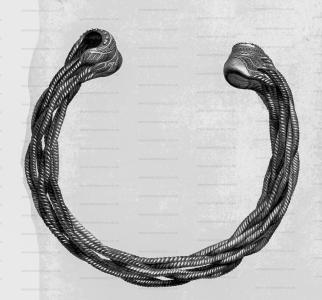Archaeologia Volume 33 Section XIII
Archaeologia Volume 33 Section XIII is in Archaeologia Volume 33.
Account of a Gold Torquis found in Needwood Forest in Staffordshire, in a Letter to the Viscount Mahon, President, from Sir HENRY ELLIS, K.H. Secretary. Read June 8th, 1848.

My Lord,
By the kindness of George Edward Anson, Esqr. I am enabled to exhibit to our Society a Torquis of fine gold, picked up a few days ago in a Wood, belonging to the Queen as Duchess of Lancaster, in Needwood Forest in Staffordshire. A new Fox earth had been made just at the place, and the Cubs appeared to have been sporting with the Torquis, which it is supposed they had dug up. It was found in its present state ( see Plate VIII. ) by the Keeper at the mouth of the hole.
The Torquis is said to be of Gaulish origin, at least the earliest mention of it in the Roman history is in the story of Manlius, in the year of Rome 394 ( or 360 B. c. ), who, having torn one of gold from the neck of a vanquished Gaul, placed it upon his own, and thence received the appellation of Torquatus.
Livy, at a little later period, in his thirty - sixth Book, tells us that Publius Cornelius in his triumph over the Boii, a people of Gaul, produced among other spoils no fewer than fourteen hundred and seventy Torques.
Subsequently, as is well known, the Torquis became a Present of military merit to the Roman soldier, whence the phrase "torquatus miles."
Aulus Gellius, it will be remembered, in his Noctes Atticæ, describes Lucius Siccius Dentatus, who was called the Roman Achilles, as having received the Torques no fewer than eighty - three times.
The Romans had a Formula for the bestowal of the Torquis.
Torques of gold have been frequently found in England, Ireland, and Wales. Many of them may be Roman, but some of them are unquestionably British. Strabo, writing under Augustus, mentions this decoration as worn by the Britons; and Dion Cassius tells us that Boadicea wore a golden torquis, when she came to her last great conflict with the Romans.
Many collars of this kind, formed of a single wreath, have been exhibited in our Society's Room; but in form and character of workmanship this, belonging to Her Majesty, is more curious and more splendid than any which have been shewn; and singularly remarkable in the number of wreaths which compose it.
Its weight is 1 lb. 1 oz. 7 dwts. 10 grains; or 5,590 grains.
Gough, in his edition of Camden's Britannia ( 1 quote that of 1789, vol. ii. p. 380 ), mentions a Torquis also found in Staffordshire, which seems to have partaken much of the flexible character observable in this which has been found in Needwood Forest; though, if the statement be correct, of much greater weight. He says, --
"At Pattingham, the estate of the Earls of Chester and the Bassets, was found, 1700, a large Torquis of gold, 3 lb. 2 oz. weight, about two feet long, curiously twisted and wreathed, with two hooks at each end, cut even but not twisted. The metal was fine and bright, and so flexible that it would wrap round the hat or arm, and easily extend again to its own shape, which resembled the bow of a kettle. "
I have the honour to be,
My Lord,
Your Lordship's faithful Servant,
Henry Ellis.
The Viscount Mahon, President.
